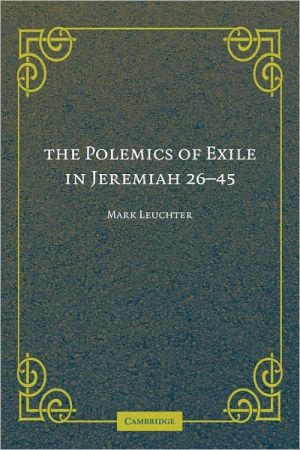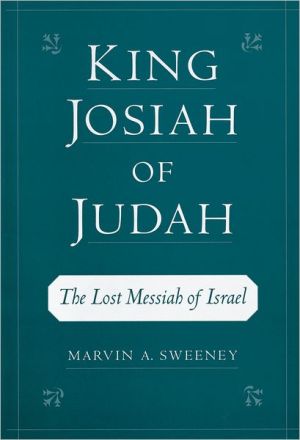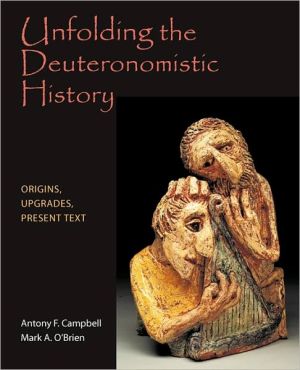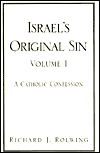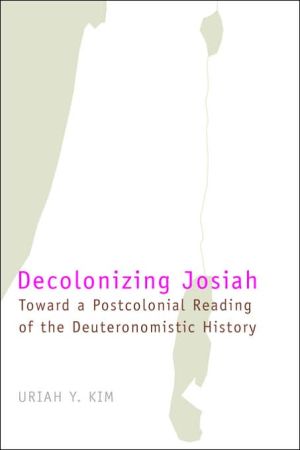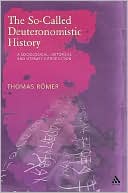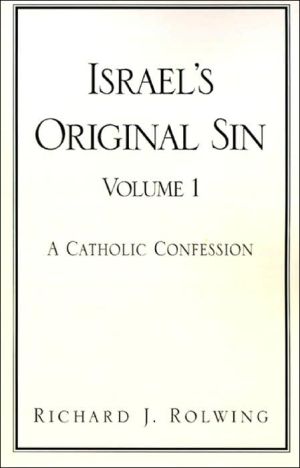The Polemics of Exile in Jeremiah 26-45
Scholars typically view Jeremiah 26-45 as a collection of episodes constructed during the Babylonian exile that attempts to prove the authenticity of Jeremiah's prophetic status. But Jeremiah's prophetic legitimacy was already widely accepted during the period of the Babylonian exile. These chapters serve a different purpose, namely, to provide a response by the Deuteronomistic scribes to the rise of the Ezekiel tradition and the Zadokite priesthood that threatened their influence among the...
Search in google:
\ Cambridge University Press \ 978-0-521-87991-0 - The Polemics of Exile in Jeremiah 26–45 - by Mark Leuchter \ Excerpt\ \ \ \ \ Introduction\ \ \ \ SCHOLARSHIP CONCERNING THE FORMATION OF THE BOOK OF JEREMIAH has, in recent years, undergone a type of renaissance. Whereas earlier approaches to the book and its formation were dominated by strict source-critical models, newer examinations have developed more intricate and advanced methods that in turn yield richer and more detailed results. Though the old source-critical paradigms are still useful in identifying literary genres within the book, they now seem rather limited in scope in terms of understanding the function of textual units, redactional growth, authorial intention, tradition history, and historical background to the Jeremianic tradition.1 While modern literary criticism has opened new avenues of analysis,2 interest in compositional and redactional analysis of the book of Jeremiah remains a staple of modern research. Most scholars have viewed the poetry in the book as largely original to the prophet, with the parenetic prose and narrative material constituting redactional additions to a once-independent collection of oracles.3 Little consensus, though, has arisen concerning the degree to which this redaction preserves the sentiments of the prophet himself.4 Still, there isgeneral agreement that the book of Jeremiah has much in common with the Deuteronomistic tradition, especially when one considers the similarities in style and tone between Deuteronomy and the Deuteronomistic History (DH) and the parenetic prose and prose narratives in the Jeremianic corpus.5\ Many have therefore postulated that the book of Jeremiah is the product of a Deuteronomistic redaction, a position most famously championed by W. Thiel.6 Thiel’s work highlights the degree to which the Jeremianic material has been subject to systematic redactions, and has been widely accepted, especially by European scholars, many of whom have offered adjustments to his analysis. T. C. Römer, for example, identifies formalistic elements within the Jeremianic material, including the repetition of stereotyped phrases at strategic points that lead him to conclude that the book went through two stages of redaction, both Deuteronomistic: an early stage that encompassed Jeremiah 7–35 and a subsequent expansion resulting in Jeremiah 1–45.7 B. Gosse has developed Römer’s theory and posited a three-stage redaction of the book.8 Both Gosse and Römer, however, retain the perspective that the poetic materials derived largely from preexilic tradition associated with the prophet himself. In this sense, both Gosse and Römer maintain the same basic position as Thiel. R. Albertz has recently adjusted this perspective, proposing a far more intricate succession of redactions influenced by a Deuteronomistic movement that arose during the exilic period and persisted into the fifth century BCE under Persia.9 For Albertz, even major poetic passages reflect the hand of a redactor, influenced largely by the diaspora–homeland tensions that occured first during the exile and later during the period of the Restoration. In this sense, no definitive Jeremianic corpus existed before a sustained, multitiered redactional process systematized and dramatically augmented whatever early and independent traditions had been associated with the prophet Jeremiah. As such, the materials in the book of Jeremiah carry only faint memories of the events of the late seventh and early sixth centuries, reflecting the needs of later communities.\ The aforementioned views are helpful in demonstrating the potential for viewing a diversity of literary units within the book but create difficulties in light of observations that already bind Jeremiah to Deuteronomistic tradition in his early oracles. For example, Thiel’s conclusions about separate authorship in the prose and poetry in Jeremiah 1–25 do not take into account the heavy reliance upon Deuteronomy already evident in the poetry, nor does he consider the function of early material in the call narrative (Jeremiah 1),10 the unique features of the Temple Sermon (Jer 7:1–15), or the colophonic nature of Jeremiah 11.11 All of these prose passages interact very strongly with the poetry not simply as exegetical accretions but also as organic parts of an original and developmental compositional period, and possess elements that speak more to Jeremiah’s authorship than to a later Deuteronomist attempting to bring an unrelated collection of poetry into the Deuteronomistic fold.\ The more recent redaction critical analyses just cited also possess difficulties. Römer’s model of Jeremiah 1–6 being secondarily added to an initial collection spanning Jeremiah 7–35 does not take into account the reliance of the Temple Sermon on material already found throughout Jeremiah 1–6; the same can be said about Jeremiah 11, which deliberately points back to these early chapters, thereby indicating their extant position as part of the same corpus.12 By the same token, many of the texts that Albertz views as deriving from postexilic authorship are already used as sources for units that almost all commentators agree upon as exilic in origin, thereby demonstrating that they most likely possess preexilic provenance. As W. M. Schniedewind has recently noted, the similarities between the Masoretic Text (MT) and Septuagint (ⅬⅩⅩ) versions of Jeremiah 1–25 confirm that these chapters obtained a recognizable form by the beginning of the exile (the point of departure between the communities sustaining these texts), pointing to an extant collection that existed by the beginning of the exile.13\ Further problems arise with the attempt to view some Jeremianic materials as deriving from the late sixth through fifth centuries BCE. B. D. Sommer’s studies of Deutero-Isaiah’s relationship to Jeremiah demonstrate conclusively that much of Jeremiah’s material already existed in a form that, by the late exilic period, was considered authoritative.14 This includes passages that are often viewed as part of a Deuteronomistic redaction, as well as poetic units that some redaction critics consider to be late as well. Sommer’s observations call into question Albertz’s proposed sixth- through fifth-century redactional accretions, which do not account for Deutero-Isaiah’s use of much of this material already by ca. 540.15 B. Halpern has also pointed to the role of certain Jeremianic texts, often viewed by redaction critics as later Deuteronomistic accretions, as influencing important theological concepts in the DH during the exile.16 For Halpern, the tradition of blaming Manasseh for the failure of the Deuteronomic reform originates in the Jeremianic corpus before the exilic updates to the DH were made.17 This is a serious problem for any scholar wishing to advocate the view that an independent Jeremianic corpus was simply brought in line with a prevailing Deuteronomistic theology by means of a broad redaction (in one stage or many) emanating from one direction. Finally, D. M. Carr’s recent proposal of a Deuteronomistic standard of education-enculturation in the late seventh century can account for similarities between much of the parenetic prose in Jeremiah and that of Deuteronomy and the DH.18 The historical Jeremiah would have certainly been trained in this method of discourse and would have readily incorporated it into his collection of oracles for rhetorical purposes, merging older modes of prophetic poetry and the contemporaneous methods of parenetic instruction into one comprehensive, multidimensional exhortation.19\ Despite these difficulties, the aforementioned redaction critics are undoubtedly correct to note that the connection between Jeremiah 1–25 and the chapters that follow is principally the result of exilic shaping and bears witness to ensuing postexilic additions. Such is the well-known position of W. M. McKane, who views the development of the Jeremianic corpus as an ad hoc accumulation of exegetical reflexes.20 A more recent study by G. Parke-Taylor follows a similar line of thought but looks to the doublets and recurring terms throughout the book as evidence of secondary scribal development.21 For Parke-Taylor, later scribes expanded their received tradition as needed by relying on terms and phrases already within the corpus. In this way, newer accretions are informed and legitimized through their connection with older material. By the same token, older passages become applicable to new circumstances arising among the audience of the text, creating a more comprehensive tradition. Thus, Parke-Taylor’s study adjusts McKane’s proposal by suggesting that the rolling corpus theory reflects a more conscious effort on the part of later writers/redactors of the received text but still advocates that many accretions were triggered by extant texts (the issue of identifying and dating these possible accretions will be discussed later).22 These redactional models highlight apparent tensions within the book as it grew over a centuries-long period of time, with disparate and conflicting political and religious perspectives voiced through the manipulation of terms and ideas in the received tradition.\ \ \ THE THEORY OF HOMELAND VERSUS GOLAH REDACTIONS\ The pivotal question in all this is why these scholars perceive such a flurry of activity that is generally characterized as contradictory in nature. As Albertz points out, the primary concern of the exile was the rift that had developed between the golah community in Babylon (beginning with the deportees of 597 and later encompassing those taken captive in 587) and those who did not settle in Mesopotamia following the destruction of Jerusalem. Much recent scholarship has been devoted to this matter concerning texts both within Jeremiah 1–25 and in subsequent chapters. C. J. Sharp has recently argued that many important texts throughout the Jeremianic corpus bear witness to two basic arguments: a “pro-golah” position reflecting the ideologues of the Babylonian community and a “pro-land” position preserving the voice of those who remained behind.23 F. Pohlmann and C. R. Seitz both see similar redactional reworking of earlier material within Jeremiah 37–44 reflecting the golah-oriented perspective, which for Seitz arises from members of the exilic community in Babylon adjusting traditions in extant texts to represent their interests.24 These scholars point to tensions within short units of text, highlighting contradictions as evidence of redaction and polemical argumentation as the various Jewish communities sought to identify themselves as the normative community of faith over against the competition. The position they advocate finds support in R. P. Carroll’s view that the image of a vacant land in Judah during the exilic period is itself a misleading polemical construct that has wrongly informed scholarly perspectives on the history of the period for too long.25\ It is impossible to imagine that the experience of the exile did not create rifts between major Jewish communities in the sixth century BCE; the literature of subsequent eras testifies to the distinctiveness of those with an exilic heritage over against those who did not endure deportation to Mesopotamia.26 This tension would have been resolved only during the days of Ezra and, eventually, the Chronicler, who went to some length to reincorporate potentially marginalized groups back into the sacred community.27 We must pause, though, before uniformly accepting the passages and fragments identified by Albertz, Sharp, Pohlmann, and Seitz as evidence of this tension within the book of Jeremiah. Some cases of apparent contradiction may instead reveal careful successive lemmatic transformation or parametric readjustment akin to the hermeneutical methods of the Deuteronomic scribes.28 In some cases, texts identified as evidencing an exilic pro-golah perspective are better understood as emerging from the prophet’s own hand in relation to well-known ancient documents, conceived to set contemporaneous events in a proper historical and political context.29\ Other apparent cases of contradiction may in fact contribute to the larger rhetoric of the narrative units in the book of Jeremiah.30 As A. R. P. Diamond has shown, the alternating nature of the relationship between Zedekiah and Jeremiah in Jeremiah 37–38 reflects a tactic of intimidation and persuasion employed by the king, and one that fits the image of a ruler who, on the one hand, emulated Deuteronomic law (and its itinerant regard for prophets) and, on the other, reduced it to an empty and self-serving ritual (Jer 34:8–22). In both cases, Zedekiah’s behavior is consistent with problems addressed by the prophet earlier in his career with respect to hypostatization of ideas, rituals, texts, or institutions.31 This is not to suggest that the characterization of the king in the current form of the text did not arise from disparate traditions. H. J. Stipp and J. Pakkala both present cogent arguments that the Jeremianic text preserves traditions that viewed Zedekiah as legitimate, and Pakkala suggests that this relates to debates about the legitimacy of dynastic succession among the descendants of Josiah.32 Nevertheless, a close reading of these passages points to a purpose behind their inclusion in the Jeremianic text that goes beyond the preservation of opposing viewpoints. In all likelihood, the favorable traditions concerning Zedekiah that Stipp and Pakkala note did indeed exist, and the Jeremianic material contains echoes of these traditions. Still, the echoes appear in narratives constructed as a counterargument to these political perspectives. As the present examination will demonstrate, passages that seem more forgiving to Zedekiah that ostensibly arise from some earlier traditions are, in fact, replete with sarcasm and foreboding elements that would not have been lost on an exilic audience and that are rhetorically connected to decidedly negative evaluations of the monarchy as an institution.\ In essence, Zedekiah’s rebellion against Babylon and his attempts to coerce Jeremiah into supporting an independent Judean community in the homeland stand in diametric opposition to the final tone and message of the Jeremianic text on this matter. While it is certainly likely that a pro-land party between 597 and 587 may have produced propaganda legitimizing their position, it is unlikely that such a party remained in Judah during the Babylonian period and set themselves the task of a careful redaction of Jeremianic texts. While a significant number of people certainly remained in the land, there is little to suggest that they would have been highly literate and capable of skillfully producing a detailed and compelling history involving the person of Jeremiah in what are now the narratives in the Jeremianic corpus.33 The literati of Judah (notably the priesthood and royal scribes) who could have written these texts would have been among those deported to Babylon in 597 and again in 587, not divided between Babylon and the homeland following Jerusalem’s destruction.34 Despite assertions to the contrary, the devastation brought on by Babylon was severe. Those who remained in the land during the period of Babylonian hegemony may not have been as destitute as the biblical text depicts, but they would have indeed been among the subelite.35 As O. Lipschits notes, the Babylonian captivity created a rift between Judeans along socioeconomic lines, with the cultural, religious, and political urban elites taken into exile and a large rural class left behind.36\ It is, to be sure, very possible that narrative and liturgical traditions developed within this community. J. Middlemas’s recent study of Lamentations and selected psalms reinforces the perspective that the works reflect a distinctively Judean response to the loss of the Temple (and, quite likely, the hardship of refugee conditions as well) in the years following 587 BCE.37 However, during this time, and indeed even during the period of 597–587, it is difficult to imagine that any remnant group in Judah or eventually Egypt would have chosen Jeremiah as a mouthpiece for its interests. The prophet had already cast his allegiance with the community that settled in Babylon as early as 597, the oracles throughout Jeremiah 1–25 repeatedly look to the rise of Babylon as inevitable and justified, and the brief accretions identified by some scholars as evidence of a pro-land perspective do not eclipse the general criticism in these chapters of the post-597 homeland community.38 At least with respect to Jeremiah 1–25, which had already obtained a discernible form by 587, it is unlikely that the Jeremianic literature received much redaction from a community in Judah following the destruction of Jerusalem.39 Indeed, the only community that would have possessed figures capable of such literary activity was the small group associated with Gedaliah b. Ahikam, but Gedaliah’s tenure was too short and tenuous to allow for dramatic reworking of the prophet’s earlier oracles, and would hardly have produced a pro-land propagandistic collection that stood against the golah-group.40 Politically speaking, a pro-Babylonian group led by Gedaliah would not have engaged in such an enterprise, as Jeremiah’s extant oracles would have served only to legitimize the political status quo following the Babylonian destruction of Jerusalem. And though it is likely that the later community under Babylonian administration in Judah did possess literate officials,41 there is no indication that they would have been members of the Shaphanide circle, contributors to the Deuteronomistic literary tradition, or adherents to its ideology.42\ A central question here concerns the Deuteronomistic tones within the book that so often characterize redactional seams and flourishes: for how long can we postulate a Deuteronomistic school or movement beyond the life of the prophet? And if we view a variety of redactional hands with opposing viewpoints at work in the redaction of the book, how may we define them as part of a coherent Deuteronomistic tradition?43\ \ \ JEREMIAH THE PROPHET AND THE DEUTERONOMISTIC\ TRADITION\ In a previous study, I supported the views of other scholars such as R. E. Friedman, M. A. Sweeney, J. A. Dearman, and J. R. Lundbom, who see a strong connection between the historical Jeremiah and the Deuteronomistic tradition circle.44 In that study, I argued that Jeremiah was selected to be a prophet because in part of his own training as a Deuteronomistic scribe, and his allegiance with the Shaphanide scribal circle (the likely authors of the Deuteronomistic literature) characterized his early activity and persisted throughout his career.45 The detailed rhetorical studies of Lundbom in particular demonstrate that stylistic/rhetorical commonalities typical of the Deuteronomistic literature permeate the various genres of text one encounters in the book of Jeremiah, arguing for common authorship in many cases in the poetic and prose oracles.46 While some of the prose may well arise from a redaction of earlier texts, this redaction is often better viewed as arising from the prophet himself than from an unrelated subsequent scribe, and the redactional material is often thematically and lexically consistent with the older texts.47 In both cases, great similarities obtain between Deuteronomistic and Jeremianic compositions.\ What reinforces the genetic connection between the Jeremiah and Deuteronomistic collections is that when we consider the polemics of contemporaneous circles of literati who stood against the prophet and his Shaphanide scribal peers, we encounter vastly different lexical, theological, and rhetorical modes of discourse.48 If the stylistic differences during this period are any indication, then distinctively Deuteronomistic language would not have been used by groups who stood against Jeremiah or the Shaphanides; they would have drawn from a countertradition of lexemes and ideas.49 Since stylistic continuity characterizes subsequent Deuteron- omistic redactional activity that many scholars view as exilic in provenance, this further questions the viability of the homeland/golah model of redaction discussed earlier, as the accretions that advocates of that model view as contradictory in nature are generally expressed within a stylistic continuum.\ What, then, of those scholars who are skeptical of ascribing Deuteron- omistic literature to writers living during Josiah’s reign and continuing during the exile? Following Albertz, many scholars have viewed the Deuteronomistic style of composition as characteristic of a single group, but one that persisted for generations well into the Persian period.50 As such, there has developed a reticence to view the narratives of 2 Kings 22–23 or the parenetic prose in Jeremiah as viable sources for historical information or evidence of thought current in the late seventh through early sixth centuries BCE.51 Here, linguistic considerations are of enormous help. The pioneering work of F. H. Polak has revealed objective criteria for dating biblical narratives. In a number of detailed examinations, Polak demonstrates that the style of composition evolves from the “lean” or “rhythmic-verbal” style of earlier narratives to the “dense” or “complex-nominal” style of narratives that date from the late eighth century on.52 The first category (lean) generally involves short clauses with limited noun groups and emulates the tradition of oral literature characteristic of a preliterate society. They may be found throughout much of the Pentateuchal patriarchal narratives as well as the narratives in the books of Samuel and Kings that are generally regarded as pre-Deuteronomistic sources dating from before the mid-eighth century BCE.53\ Polak’s second category (dense) involves material conceived in a milieu strongly influenced by the neo-Assyrian, Babylonian, and Persian scribal chancery and involves long, ornate clauses, a higher frequency of subordinate or embedded clauses (complex hypotaxis), and longer noun groups.54 These narratives are also characterized by certain sociolinguistic features such as a presupposition of increased literacy, education, written law codes, and other authoritative written texts that go largely unmentioned in the lean texts of the earlier period.55 Though these features are common to texts from the late seventh through mid-fourth centuries BCE, Polak identifies an increase in complex hypotaxis and length in noun groups in documents set in the Persian period, reflecting the degree to which the Persian administrative infrastructure had come to dominate the compositional consciousness of the biblical writers.56 Finally, the stylistic differences in Persian-period texts and those set in the neo-Assyrian and Babylonian periods is not a matter of personal preference on the part of the writer: Persian- period writers rarely reengage the less complex style of texts from the neo-Assyrian or Babylonian periods, just as the writers of those periods do not reengage the style of the earlier, lean compositions that emulates oral modes of composition.57\ \ \ \ \ \ © Cambridge University Press
\ Acknowledgments vii\ List of Abbreviations ix\ Note on Citations xiii\ Introduction 1\ The Hermeneutics of Citation: Jeremiah 26 25\ The Identification of Legitimate Israel: Jeremiah 27-32:15 39\ The Redaction of Jeremiah 1-25:13+OAN 66\ The Reengagement of the Royal Line in Jeremiah 33:14-26 72\ The Standards of Faith and Intermediation: Jeremiah 34-36 82\ The Fall of Judah, the Descent into Egypt, and Baruch ben Neriah: Jeremiah 37-45 113\ The "words of Jeremiah" and Seraiah's Colophon in the MT and LXX Traditions 142\ The Polemics of Exile 145\ The Exilic Coalition between the Shaphanides and Levites 166\ Conclusion 177\ Notes 195\ Bibliography 279\ Author Index 299\ Scriptural and Extra-Biblical Texts Index 304\ Subject Index 316
\ From the PublisherReview of the hardback: 'Leuchter is fully conversant with recent Jeremianic scholarship, and it is in his interaction with this scholarship that he generates new ideas about the text. The specificity of the evidence produced by Leuchter is impressive and will no doubt promote significant discussion among scholars and others interested in the development of the book of Jeremiah.' Jeoffrey Geoghegan, Boston College\ Review of the hardback: 'This book is well conceived, researched in detail, and carefully argued. Leuchter is largely traditional in refining the redactional features of the 'biography of Jeremiah,' and in demonstratnig its correlation with and impact on other scribal redactional efforts in the Second Temple. This book expands our possible understanding of the redactional history of Jeremiah, complicated of course by the shorter LXX text.' Leo Perdue, Texas Christian University\ \ \
